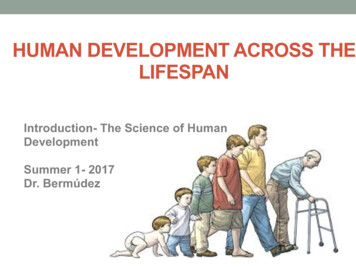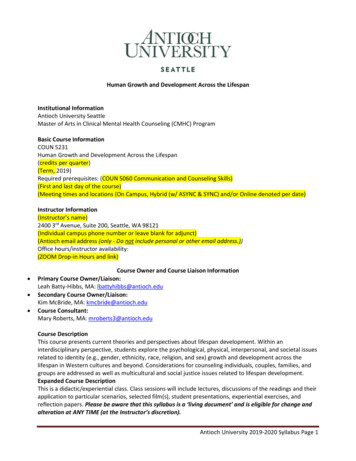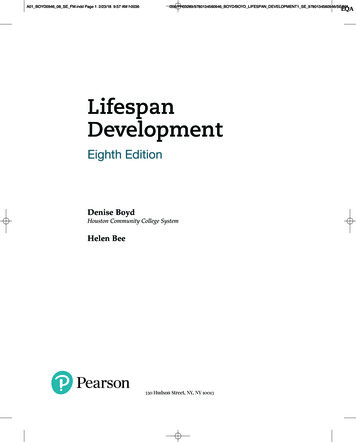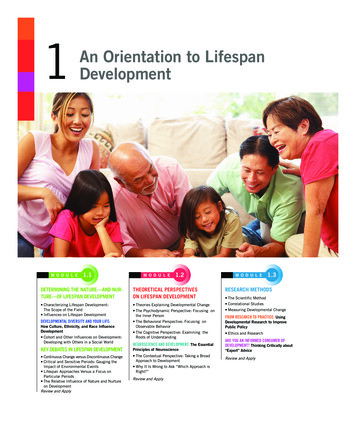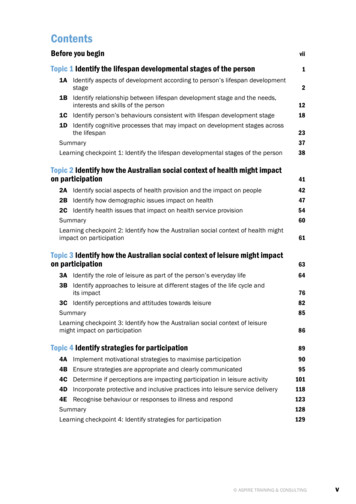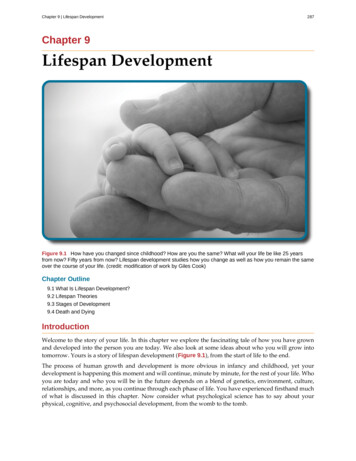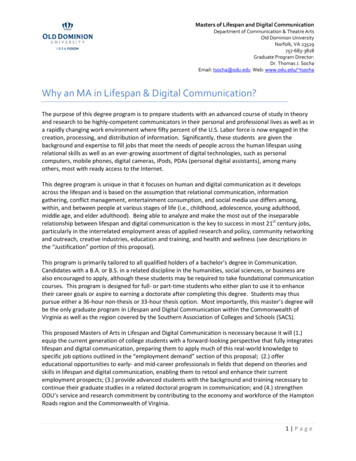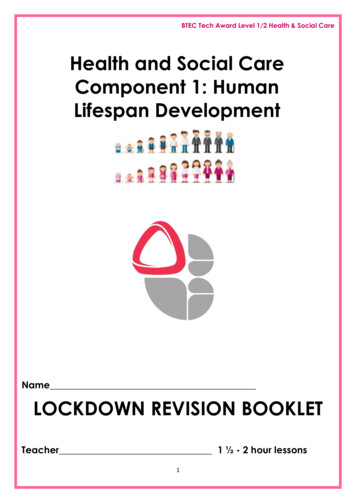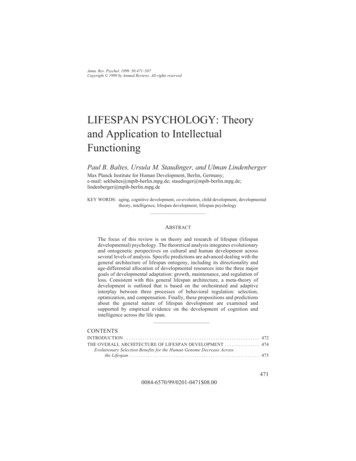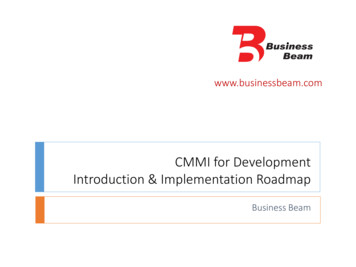
Transcription
FLDNMC01 002-041-hrAn Introduction to Lifespan Development15/4/104:17 PMPage 2
FLDNMC01 002-041-hr5/4/104:17 PMPage 31An Introduction toLifespan DevelopmentPROLOGUE: The Oldest Newest MotherIn May 2009, British businesswoman Elizabeth Adeney gave birth to a 5 pound 3 ounce infantboy. This would not be remarkable, of course, except for one startling fact: Elizabeth Adeneywas 66 years old at the time of her child’s delivery. At the time, Elizabeth Adeney was the oldest woman to have ever given birth in the United Kingdom. 쑺Elizabeth Adeney.CHAPTER OVERVIEWAN ORIENTATION TO LIFESPANDEVELOPMENTCharacterizing Lifespan Development: TheScope of the FieldCohort and Other Influences onDevelopment: Developing with Others in aSocial WorldKEY ISSUES AND QUESTIONS:DETERMINING THE NATURE—ANDNURTURE—OF LIFESPANDEVELOPMENTContinuous Change VersusDiscontinuous ChangeCritical and Sensitive Periods: Gauging theImpact of Environmental EventsLifespan Approaches Versus a Focus onParticular PeriodsThe Relative Influence of Nature andNurture on DevelopmentEvolutionary Perspectives: Our Ancestors’Contributions to BehaviorWhy “Which Approach Is Right?” Is theWrong QuestionTHEORETICAL PERSPECTIVES ONLIFESPAN DEVELOPMENTRESEARCH METHODSThe Psychodynamic Perspective: Focusingon the Inner PersonThe Behavioral Perspective: Focusing onObservable BehaviorThe Cognitive Perspective: Examining theRoots of UnderstandingThe Humanistic Perspective: Concentratingon the Unique Qualities of Human BeingsThe Contextual Perspective: Taking a BroadApproach to DevelopmentTheories and Hypotheses: PosingDevelopmental QuestionsChoosing a Research Strategy: AnsweringQuestionsCorrelational StudiesExperiments: Determining Cause and EffectTheoretical and Applied Research:Complementary ApproachesMeasuring Developmental ChangeEthics and Research3
FLDNMC01 002-041-hr4PART 15/4/10쑺4:17 PMPage 4BeginningsIt has been more than 30 years since the birth of the world’s first “test tube baby,” LouiseBrown, born by in vitro fertilization (IVF). This is a procedure in which fertilization of amother’s egg by a father’s sperm takes place outside of the mother’s body. In the decades thatfollowed Louise’s birth, medical technology has continued to progress by leaps and bounds.Whereas at the time Louise’s birth made headlines, today in vitro fertilization is a relativelycommon procedure. Fertility science has progressed to the point where even a relativelyelderly woman like Elizabeth Adeney can deliver a baby.Yet even as the possibilities of conception became increasingly varied, the development ofhuman beings still often follows a predictable pattern: from infancy, through childhood andadolescence, and to marriage and parenthood. Though the specifics of development vary—some of us encounter economic deprivation or live in war-torn territories; others contendwith genetic or family issues such as divorce and stepparents—the broad strokes of development are remarkably similar for all of us. Shaquille O’Neal, Donald Trump, the Queen of England, and each and every one of us are traversing the territory known as lifespan development.Elizabeth Adeney’s late-in-life pregnancy provoked controversy. Yet it represents only oneof the brave new worlds of 21st-century life. Issues ranging from cloning to the consequencesof poverty for development to the prevention of AIDS raise significant concerns about factorsthat affect human development. Underlying these problems are even more fundamentalissues: How do we develop physically? How does our understanding of the world growand change throughout our lives? And how do our personalities and our social relationshipsdevelop as we move from birth through the entire span of our lives?Each of these questions, and many others we’ll encounter throughout this book, is centralto the field of lifespan development. As a field, lifespan development encompasses not only abroad span of time—from before birth to death—but also a wide range of areas of development. Consider, for example, the range of interests that different specialists in lifespandevelopment focus on when considering Elizabeth Adeney’s son:쎲Lifespan development researchers who investigate behavior at the level of biologicalprocesses might determine whether the functioning of Adeney’s baby was affected by theadvanced age of his birth mother.쎲Specialists in lifespan development who study genetics might examine how his geneticendowment shaped his later behavior.쎲For lifespan development specialists who investigate the ways that thinking changes overthe course of life, Adeney’s son’s life might be examined in terms of how his understandingof his birth changed as he grew older.쎲Other researchers in lifespan development, who focus on physical growth, might considerwhether his growth rate differed from those of children of younger mothers.쎲Lifespan development experts who specialize in the social world and social relationshipsmight look at the ways he interacted with others and the kinds of friendships he developed.Although their interests take many forms, these specialists in lifespan development shareone concern: understanding the growth and change that occur during the course of life. Taking many differing approaches, developmentalists study how our biological inheritance fromour parents and the environment in which we live jointly affect our behavior.Some developmentalists focus on explaining how our genetic background can determinenot only how we look but also how we behave and relate to others in a consistent manner—that is, matters of personality. They explore ways to identify how much of our potential ashuman beings is provided—or limited—by heredity. Other lifespan development specialistslook to the environment, exploring ways in which our lives are shaped by the world that weencounter. They investigate the extent to which we are shaped by our early environments, andhow our current circumstances influence our behavior in both subtle and evident ways.Whether they concentrate on heredity or environment, all developmental specialists acknowledge that neither heredity nor environment alone can account for the full range of
FLDNMC01 002-041-hr5/4/104:17 PMPage 5CHAPTER 1쑺An Introduction to Lifespan Development5human development and change. Instead, our understanding of people’s development requires that we look at the joint effects of the interaction of heredity and environment,attempting to grasp how both, in the end, underlie human behavior.In this chapter, we orient ourselves to the field of lifespan development. We begin with adiscussion of the scope of the discipline, illustrating the wide array of topics it covers and thefull range of ages it examines. We also survey the key issues and controversies of the field andconsider the broad perspectives that developmentalists take. Finally, we discuss the ways developmentalists use research to ask and answer questions.After reading this chapter, you will be able to answer these questions:쏋What is lifespan development, and what are some of the basic influences on humandevelopment?쏋What are the key issues in the field of development?쏋Which theoretical perspectives have guided lifespan development?쏋What role do theories and hypotheses play in the study of development?쏋How are developmental research studies conducted?LOOKINGAHEADAN ORIENTATION TO LIFESPAN DEVELOPMENTlifespan development the field of study thatHave you ever wondered how it is possible that an infant tightly grips your finger with tiny,examines patterns of growth, change, and stabilityperfectly formed hands? Or marveled at how a preschooler methodically draws a picture? Orin behavior that occur throughout the entireat the way an adolescent can make involved decisions about whom to invite to a party or the life spanethics of downloading music files? Or the way a middle-aged politician can deliver a long,flawless speech from memory? Or wondered what it is that makes a grandfather at 80 so similar to the father he was when he was 40?If you’ve ever wondered about such things, you are asking the kinds of questions that scientists in the field of lifespan development pose. Lifespan development is the field of study thatexamines patterns of growth, change, and stability in behavior that occur throughout the entire life span.Although the definition of the field seems straightforward, the simplicity issomewhat misleading. In order to understand what development is actuallyabout, we need to look underneath the various parts of the definition.In its study of growth, change, and stability, lifespan development takes ascientific approach. Like members of other scientific disciplines, researchers inlifespan development test their assumptions about the nature and course ofhuman development by applying scientific methods. As we’ll see later in thechapter, they develop theories about development, and they use methodical, scientific techniques to validate the accuracy of their assumptions systematically.Lifespan development focuses on human development. Although there aredevelopmentalists who study the course of development in nonhuman species,the vast majority examine growth and change in people. Some seek to understand universal principles of development, whereas others focus on how cultural, racial, and ethnic differences affect the course of development. Stillothers aim to understand the unique aspects of individuals, looking at thetraits and characteristics that differentiate one person from another. Regardlessof approach, however, all developmentalists view development as a continuingprocess throughout the life span.As developmental specialists focus on the ways people change and growduring their lives, they also consider stability in people’s lives. They ask inwhich areas, and in what periods, people show change and growth, and when How people grow and change over the course of their lives is theand how their behavior reveals consistency and continuity with prior behavior. focus of lifespan development.
FLDNMC01 002-041-hr6PART 15/4/10쑺4:17 PMPage 6Beginningsphysical development development involvingthe body’s physical makeup, including the brain,nervous system, muscles, and senses, and the needfor food, drink, and sleeppersonality development developmentFinally, developmentalists assume that the process of development persists throughoutevery part of people’s lives, beginning with the moment of conception and continuing untildeath. Developmental specialists assume that in some ways people continue to grow andchange right up to the end of their lives, while in other respects their behavior remains stable.At the same time, developmentalists believe that no particular, single period of life governs alldevelopment. Instead, they believe that every period of life contains the potential for bothgrowth and decline in abilities, and that individuals maintain the capacity for substantialgrowth and change throughout their lives.involving the ways that the enduringcharacteristics that differentiate one personfrom another change over the life spanCharacterizing Lifespan Development: The Scope of the Fieldcognitive development developmentinvolving the ways that growth and change inintellectual capabilities influence a person’sbehaviorsocial development the way in whichindividuals’ interactions with others and theirsocial relationships grow, change, and remainstable over the course of lifeClearly, the definition of lifespan development is broad and the scope of the field is extensive.Consequently, lifespan development specialists cover several quite diverse areas, and a typicaldevelopmentalist will choose to specialize in both a topical area and an age range.TOPICAL AREAS IN LIFESPAN DEVELOPMENT. Some developmentalists focus onphysical development, examining the ways in which the body’s makeup—the brain, nervoussystem, muscles, and senses, and the need for food, drink, and sleep—helps determine behavior. For example, one specialist in physical development might examine the effects of malnutrition on the pace of growth in children, while another might look at how athletes’ physicalperformance declines during adulthood (Fell & Williams, 2008).Other developmental specialists examine cognitive development, seeking to understandhow growth and change in intellectual capabilities influence a person’s behavior. Cognitivedevelopmentalists examine learning, memory, problem-solving skills, and intelligence. For example, specialists in cognitive development might want to see how problem-solving skillschange over the course of life, or whether cultural differences exist in the way people explaintheir academic successes and failures. They would also be interested in how a person who experiences significant or traumatic events early in life would remember them later in life(Alibali, Phillips, & Fischer, 2009; Dumka et al., 2009).Finally, some developmental specialists focus on personality and social development.Personality development is the study of stability and change in the enduring characteristicsthat differentiate one person from another over the life span. Social development is the way inwhich individuals’ interactions with others and their social relationships grow, change, and remain stable over the course of life. A developmentalist interested in personality developmentmight ask whether there are stable, enduring personality traits throughout the life span, whereas a specialist in social development might examine the effects of racism or poverty or divorceon development (Evans, Boxhill, & Pinkava, 2008; Lansford, 2009). These four major topicareas—physical, cognitive, social, and personality development—are summarized in Table 1-1.AGE RANGES AND INDIVIDUAL DIFFERENCES. In addition to choosing to specializein a particular topical area, developmentalists also typically look at a particular age range. Thelife span is usually divided into broad age ranges: the prenatal period (the period from conception to birth); infancy and toddlerhood (birth to age 3); the preschool period (ages 3 to 6);middle childhood (ages 6 to 12); adolescence (ages 12 to 20); young adulthood (ages 20 to 40);middle adulthood (ages 40 to 65); and late adulthood (age 65 to death).It’s important to keep in mind that these broad periods—which are largely accepted bylifespan developmentalists—are social constructions. A social construction is a shared notionof reality, one that is widely accepted but is a function of society and culture at a given time.Consequently, the age ranges within a period—and even the periods themselves—are in manyways arbitrary and often culturally derived. For example, later in the book we’ll discuss howthe concept of childhood as a special period did not even exist during the 17th century; at thattime, children were seen simply as miniature adults. Furthermore, while some periods have aclear-cut boundary (infancy begins with birth, the preschool period ends with entry into public school, and adolescence starts with sexual maturity), others don’t.
FLDNMC01 002-041-hr5/4/104:17 PMPage 7CHAPTER 1쑺An Introduction to Lifespan DevelopmentTABLE 1-1 Approaches to Lifespan DevelopmentOrientationDefining CharacteristicsExamples of Question Asked*Physical developmentEmphasizes how brain, nervous system,muscles, sensory capabilities, needs forfood, drink, and sleep affect behavior Cognitive developmentEmphasizes intellectual abilities,including learning, memory, problemsolving, and intelligenceWhat determines the sex of a child? (2)What are the long-term results of premature birth? (3)What are the benefits of breast milk? (4)What are the consequences of early or late sexualmaturation? (1)What leads to obesity in adulthood? (13)How do adults cope with stress? (15)What are the outward and internal signs of aging? (17)How do we define death? (19) What are the earliest memories that can be recalled frominfancy? (5) What are the intellectual consequences of watchingtelevision? (7) Do spatial reasoning skills relate to music practice? (7) Are there benefits to bilingualism? (9) How does an adolescent’s egocentrism affect his or herview of the world? (11) Are there ethnic and racial differences in intelligence? (9) How does creativity relate to intelligence? (13) Does intelligence decline in late adulthood? (17)Personality and socialdevelopmentEmphasizes enduring characteristics thatdifferentiate one person from another,and how interactions with others andsocial relationships grow and changeover the lifetime Do newborns respond differently to their mothers than to others? (3)What is the best procedure for disciplining children? (8)When does a sense of gender identity develop? (8)How can we promote cross-race friendships? (10)What are the causes of adolescent suicide? (12)How do we choose a romantic partner? (14)Do the effects of parental divorce last into old age? (18)Do people withdraw from others in late adulthood? (18)What are the emotions involved in confronting death? (19)*Numbers in parentheses indicate in which chapter the question is addressed.For instance, consider the period of young adulthood, which at least in Western cultures istypically assumed to begin at age 20. That age, however, is notable only because it marks theend of the teenage period. In fact, for many people, such as those enrolled in higher education,the age change from 19 to 20 has little special significance, coming as it does in the middle ofthe college years. For them, more substantial changes may occur when they leave college andenter the workforce, which is more likely to happen around age 22. Furthermore, in somenon-Western cultures, adulthood may be considered to start much earlier, when childrenwhose educational opportunities are limited begin full-time work.In short, there are substantial individual differences in the timing of events in people’s lives.In part, this is a biological fact of life: People mature at different rates and reach developmental milestones at different points. However, environmental factors also play a significant role indetermining the age at which a particular event is likely to occur. For example, the typical ageof marriage varies substantially from one culture to another, depending in part on the functions that marriage plays in a given culture.7
FLDNMC01 002-041-hr8PART 15/4/10쑺4:17 PMPage 8BeginningsIt is important to keep in mind, then, that when developmental specialists discuss ageranges, they are talking about averages—the times when people, on average, reach particular milestones. Some people will reach the milestone earlier, some later, and many will reachit around the time of the average. Such variation becomes noteworthy only when childrenshow substantial deviation from the average. For example, parents whose child begins tospeak at a much later age than average might decide to have their son or daughter evaluatedby a speech therapist.THE LINKS BETWEEN TOPICS AND AGES. Each of the broad topical areas of lifespandevelopment—physical, cognitive, social, and personality development—plays a rolethroughout the life span. Consequently, some developmental experts focus on physical development during the prenatal period, and others during adolescence. Some might specialize insocial development during the preschool years, while others look at social relationships in lateadulthood. And still others might take a broader approach, looking at cognitive developmentthrough every period of life.In this book, we’ll take a comprehensive approach, proceeding chronologically from theprenatal period through late adulthood and death. Within each period, we’ll look at differenttopical areas: physical, cognitive, social, and personality. Furthermore, we’ll also be considering the impact of culture on development, as we discuss next.This wedding of two children in India is anexample of how environmental factors can playa significant role in determining the age when aparticular event is likely to occur.DEVELOPMENTAL DIVERSITY AND YOUR LIFEHow Culture, Ethnicity, and Race Influence DevelopmentMayan mothers in Central America are certain that almost constant contact between themselves and their infant children is necessary for good parenting, and they are physically upset ifcontact is not possible. They are shocked when they see a North American mother lay her infantdown, and they attribute the baby’s crying to the poor parenting of the North American.(Morelli et al., 1992)쏄쏄쏄What are we to make of the two views of parenting expressed in this passage? Is one right andthe other wrong? Probably not, if we take into consideration the cultural context in which themothers are operating. Different cultures and subcultures have their own views of appropriateand inappropriate childrearing, just as they have different developmental goals for children(Tolchinsky, 2003; Feldman & Masalha, 2007; Huijbregts et al., 2009).It has become clear that in order to understand development, developmentalists must takeinto consideration broad cultural factors, such as an orientation toward individualism or collectivism. They must also consider finer ethnic, racial, socioeconomic, and gender differencesif they are to achieve an understanding of how people change and grow throughout the lifespan. If developmentalists succeed in doing so, not only can they achieve a better understanding of human development, but they may be able to derive more precise applications forimproving the human social condition.Efforts to understand how diversity affects development have been hindered by difficultiesin finding an appropriate vocabulary. For example, members of the research community—aswell as society at large—have sometimes used terms such as race and ethnic group in inappropriate ways. Race is a biological concept, which should be employed to refer to classificationsbased on physical and structural characteristics of species. In contrast, ethnic groupand ethnicity are broader terms, referring to cultural background, nationality, religion, andlanguage.The concept of race has proven especially problematic. Although it formally refers to biological factors, race has taken on substantially more meanings—many of them inappropriate—that range from skin color to religion to culture. Moreover, the concept of race isexceedingly imprecise; depending on how it is defined, there are between 3 and 300 races, andno race is genetically distinct. The fact that 99.9% of humans’ genetic makeup is identical in all
FLDNMC01 002-041-hr5/4/104:17 PMPage 9CHAPTER 1쑺An Introduction to Lifespan Developmenthumans makes the question of race seem comparatively insignificant (Bamshad & Olson,2003; Helms, Jernigan, & Mascher, 2005; Smedley & Smedley, 2005).In addition, there is little agreement about which names best reflect different races andethnic groups. Should the term African American—which has geographical and cultural implications—be preferred over black, which focuses primarily on skin color? Is Native Americanpreferable to Indian? Is Hispanic more appropriate than Latino? And how can researchersaccurately categorize people with multiethnic backgrounds? The choice of category hasimportant implications for the validity and usefulness of research. The choice even has political implications. For example, the decision to permit people to identify themselves as“multiracial” on U.S. government forms and in the 2000 U.S. Census was highly controversial(Perlmann & Waters, 2002).In order to fully understand development, then, we need to take the complex issues associated with human diversity into account. It is only by looking for similarities and differencesamong various ethnic, cultural, and racial groups that developmental researchers can distinguish principles of development that are universal from principles that are culturally determined. In the years ahead, then, it is likely that lifespan development will move from adiscipline that focuses primarily on North American and European development to one thatencompasses development around the globe (Fowers & Davidov, 2006; Matsumoto & Yoo,2006; Kloep et al., 2009).cohort a group of people born at around thesame time in the same placeCohort and Other Influences on Development: Developingwith Others in a Social WorldBob, born in 1947, is a baby boomer; he was born soon after the end of World War II, when anenormous bulge in the birth rate occurred as soldiers returned to the United States from overseas. He was an adolescent at the height of the civil rights movement and the beginning ofprotests against the Vietnam War. His mother, Leah, was born in 1922; she is part of the generation that passed its childhood and teenage years in the shadow of the Great Depression. Bob’sson, Jon, was born in 1975. Now building a career after graduating from college and startinghis own family, he is a member of what has been called Generation X. Jon’s younger sister,Sarah, who was born in 1982, is part of the next generation, which sociologists have called theMillennial Generation.These people are in part products of the social times in which they live. Each belongs to aparticular cohort, a group of people born at around the same time in the same place. Suchmajor social events as wars, economic upturns and depressions, famines, and epidemics (likethe one due to the AIDS virus) work similar influences on members of a particular cohort(Mitchell, 2002; Dittmann, 2005).Cohort effects provide an example of history-graded influences, which are biological and environmental influences associated with a particular historical moment. For instance, peoplewho lived in New York City during the 9/11 terrorist attack on the World Trade Center experienced shared biological and environmental challenges due to the attack (Bonanno et al., 2006;Laugharne, Janca, & Widiger, 2007). In contrast, age-graded influences are biological and environmental influences that are similar for individuals in a particular age group, regardless ofwhen or where they are raised. For example, biological events such as puberty and menopauseare universal events that occur at relatively the same time throughout all societies. Similarly, asociocultural event such as entry into formal education can be considered an age-gradedinfluence because it occurs in most cultures around age 6.Development is also affected by sociocultural-graded influences, the social and cultural factors present at a particular time for a particular individual, depending on such variables asethnicity, social class, and subcultural membership. For example, sociocultural-graded influences will be considerably different for children who are white and affluent than for childrenwho are members of a minority group and living in poverty (Rose et al., 2003).Froman educator’sperspective:How would a student’scohort membership affecthis or her readiness forschool? For example, whatwould be the benefits anddrawbacks of coming from acohort in which Internet usewas routine, compared withearlier cohorts prior tothe appearance ofthe Internet?9
FLDNMC01 002-041-hr10PART 15/4/10쑺4:17 PMPage 10Beginningscontinuous change gradual development inwhich achievements at one level build on those ofprevious levelsFinally, non-normative life events are specific, atypical events that occur in a person’s life ata time when such events do not happen to most people. For example, a child whose parentsdie in an automobile accident when she is 6 years old has experienced a significant nonnormative life event.KEY ISSUES AND QUESTIONS: DETERMININGTHE NATURE—AND NURTURE—OF LIFESPANDEVELOPMENTLifespan development is a decades-long journey. Though there are some shared markers alongthe way—such as learning to speak, going to school, and finding a job—there are, as we have justseen, many individual routes with twists and turns along the way that also influence this journey.For developmentalists working in the field, the range and variation in lifespan developmentraises a number of issues and questions. What are the best ways to think about the enormouschanges that a person undergoes from before birth to death? How important is chronologicalage? Is there a clear timetable for development? How can one begin to find common threadsand patterns?These questions have been debated since lifespan development first became established as aseparate field in the late 19th and early 20th centuries, though a fascination with the natureand course of human development can be traced back to the ancient Egyptians and Greeks.We will look at some of these issues, which are summarized in Table 1-2.Continuous Change Versus Discontinuous ChangeOne of the primary issues challenging developmentalists is whether development proceeds ina continuous or discontinuous fashion. In continuous change, development is gradual, withachievements at one level building on those of previous levels. Continuous change is quantitative in nature; the basic underlying developmental processes that drive change remain thesame over the course of the life span. Continuous change, then, produces changes that are amatter of degree, not of kind. Changes in height prior to adulthood, for example, are continuous. Similarly, as we’ll see later in the chapter, some theorists suggest that changes in people’sthinking capabilities are also continuous, showing gradual quantitative improvements ratherthan developing entirely new cognitive processing capabilities.TABLE 1-2 Major Issues in Lifespan DevelopmentContinuous Change Change is gradual. Achievements at one level build on previous level. Underlying developmental processes remain the sameover the lifespan.Discontinuous Change Change occurs in distinct steps or stages. Behavior and processes are qualitatively different atdifferent stages.Critical Periods Certain environmental stimuli are necessary for normaldevelopment. Emphasized by early developmentalists.Sensitive Periods People are susceptible to certain environmental stimuli, butc
human development and change. Instead, our understanding of people’s development re- . life span How people grow and change over the course of their lives is the focus of lifespan development. FLDNMC01_002-041-hr 5/4/10 4:17 PM Page 5. Finally, developmentalists assume that the process of development persists throughout .
